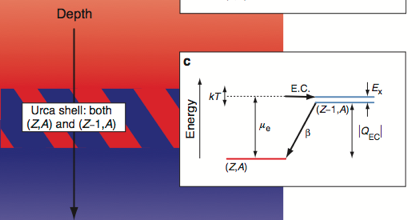
As matter is pushed through an electron capture layer, where the electron chemical potential exceeds the reaction Q-value, the finite temperature makes it possible for electron captures and β decays to cycle rapidly. Since these reactions emit neutrinos, this cycling is an efficient energy sink for the neutron star crust. From Schatz et al. (2014).
A Strong Neutrino Cooling Process in Neutron Star Crusts
The temperature in the crust of an accreting neutron star is set by the balance of accretion-induced nuclear reactions, neutrino cooling, and the conductive transport of heat to the surface and core. Schatz et al. found that electron-capture/β-decay cycles onto neutron-rich nuclei can efficiently emit neutrinos thereby cooling the crust and thermally decoupling the thin envelope of accreted light elements from deeper crust layers. This thermal decoupling implies that explosions on the neutron star surface—X-ray bursts and superbursts—are largely independent of the thermal state of the neutron star interior.